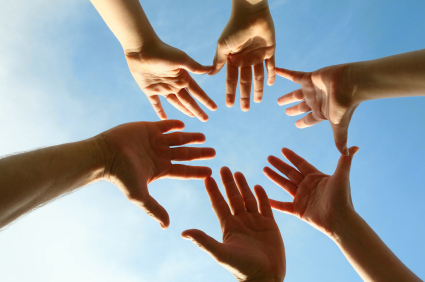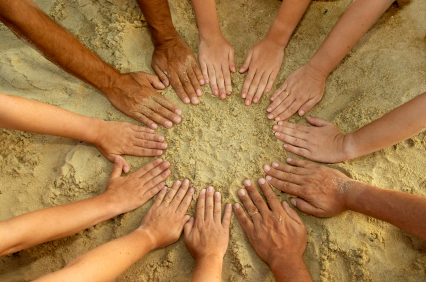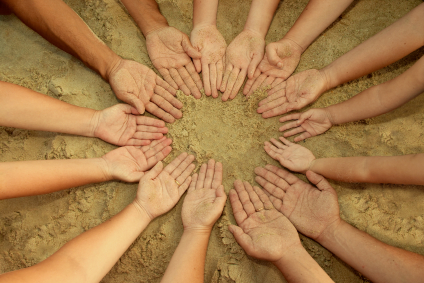Skip over navigation
It would be good to work with other people for this challenge.
You'll need to split up into five groups.
Each group will need to have copies of one of the pictures below. (This sheet contains one of each picture.)
In your group, find out how many fingers (including thumbs) there are in the picture you have been given.
Talk to others in your group about how you came to that total and compare your way with other people's ways. Make sure you agree on the number as a whole group.
You may like to record what you have done in some way.





Swap pictures with another group.
How many fingers, including thumbs, this time? Did you change the way you worked it out?
Once again, talk to others in your group about how you each came to that total.
You could swap your pictures again and keep going until you have had a chance to see all five pictures.
As a class share the different ways that you counted.
Are there some ways that were more popular for particular pictures than others? Why was this, do you think?
There is another activity on NRICH, Alien Counting, which starts like this:-

Well here are five Aliens, all from different planets.
They all count using one "hand" except the last one who uses his six tentacles.
So let me introduce them:
1st - Serious "Dubo" who counts in twos;
2nd - The two headed "Threebee" who counts in threes;
3rd - The laughing "Quort", who counts in fours;
4th - The green-headed "Chindi" who (you guessed it) counts in fives;
Finally - The four-eyed "Senda" counting in sixes.
What if Dubo, Threebee, Quort, Chindi or Senda had been there in the hand pictures instead of humans?
Which Aliens could be in which pictures if you wanted the total to be the same as with humans?
What numbers of fingers would there be if each human in each picture were to be replaced by an Alien of your choice?



Or search by topic
Number and algebra
Geometry and measure
Probability and statistics
Working mathematically
Advanced mathematics
For younger learners
Fingers and Hands
Age 7 to 11
Challenge Level 





Here's something a little different ...
It is an opportunity to work with many aspects of mathematics.
It would be good to work with other people for this challenge.
You'll need to split up into five groups.
Each group will need to have copies of one of the pictures below. (This sheet contains one of each picture.)
In your group, find out how many fingers (including thumbs) there are in the picture you have been given.
Talk to others in your group about how you came to that total and compare your way with other people's ways. Make sure you agree on the number as a whole group.
You may like to record what you have done in some way.





Swap pictures with another group.
How many fingers, including thumbs, this time? Did you change the way you worked it out?
Once again, talk to others in your group about how you each came to that total.
You could swap your pictures again and keep going until you have had a chance to see all five pictures.
As a class share the different ways that you counted.
Are there some ways that were more popular for particular pictures than others? Why was this, do you think?
There is another activity on NRICH, Alien Counting, which starts like this:-

Well here are five Aliens, all from different planets.
They all count using one "hand" except the last one who uses his six tentacles.
So let me introduce them:
1st - Serious "Dubo" who counts in twos;
2nd - The two headed "Threebee" who counts in threes;
3rd - The laughing "Quort", who counts in fours;
4th - The green-headed "Chindi" who (you guessed it) counts in fives;
Finally - The four-eyed "Senda" counting in sixes.
What if Dubo, Threebee, Quort, Chindi or Senda had been there in the hand pictures instead of humans?
Which Aliens could be in which pictures if you wanted the total to be the same as with humans?
What numbers of fingers would there be if each human in each picture were to be replaced by an Alien of your choice?
You may also like
Month Mania
Can you design a new shape for the twenty-eight squares and arrange the numbers in a logical way? What patterns do you notice?
Neighbours
In a square in which the houses are evenly spaced, numbers 3 and 10 are opposite each other. What is the smallest and what is the largest possible number of houses in the square?
Page Numbers
Exactly 195 digits have been used to number the pages in a book. How many pages does the book have?

